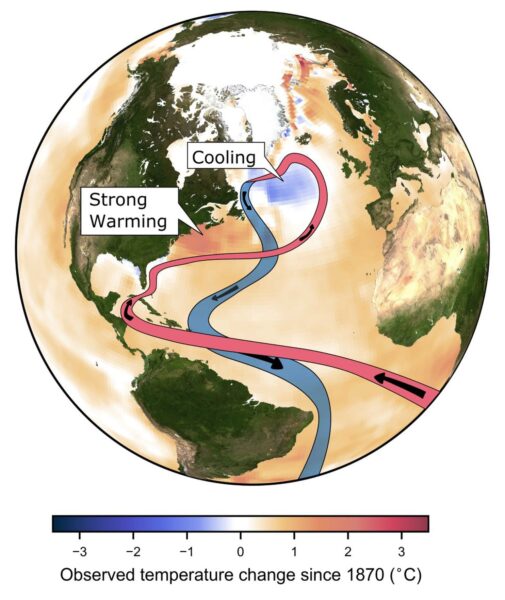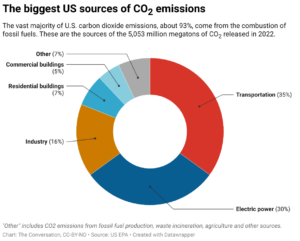Enhanced shortwave absorption by water vapor increases effective climate sensitivity via accelerated AMOC recovery – Nature

Report on the Influence of Atmospheric Shortwave Absorption on Climate Sensitivity and its Implications for Sustainable Development Goals
This report details findings on the significant, yet underexplored, impact of clear-sky shortwave absorption (SWA) on climate model projections. The study reveals a critical pathway through which uncertainties in SWA affect the Atlantic Meridional Overturning Circulation (AMOC) and, consequently, the overall climate sensitivity to CO₂ emissions. These findings have profound implications for the international community’s ability to achieve key Sustainable Development Goals (SDGs), particularly SDG 13 (Climate Action), SDG 14 (Life Below Water), and SDG 17 (Partnerships for the Goals).
Analysis of Climate Model Uncertainties and SDG Implications
Accurate climate projections are fundamental to developing effective strategies for SDG 13 (Climate Action). This research isolates the effect of SWA uncertainty, a factor often overshadowed by cloud feedbacks, to demonstrate its substantial influence on climate system dynamics.
Impact of SWA on Mean Climate State and Ocean Circulation (SDG 13, SDG 14)
The initial state of the climate system is a determinant of its future response. The study demonstrates that variations in SWA within the range of current model uncertainty lead to significantly different baseline climates. This directly impacts the scientific foundation upon which climate action policies are built.
- Arctic Climate and Sea Ice: Enhanced SWA reduces surface shortwave radiation, causing amplified cooling in the Arctic. This directly influences sea ice extent, a critical component of the marine ecosystems protected under SDG 14, and a key regulator of global climate relevant to SDG 13.
- Atlantic Meridional Overturning Circulation (AMOC): The SWA-induced Arctic cooling leads to denser surface water in deep convection regions (Irminger and Labrador Seas). This results in a stronger baseline AMOC, a cornerstone of global ocean circulation. The stability of the AMOC is vital for marine biodiversity, fisheries, and regional climate patterns, linking directly to the objectives of SDG 14.
CO₂-Forced Climate Response and AMOC Dynamics (SDG 13, SDG 14)
The report assesses the climate response to an abrupt quadrupling of CO₂, a standard experiment for evaluating climate sensitivity. The results show that the initial SWA value critically determines the long-term evolution of the AMOC, a major tipping element in the Earth’s climate system.
- Initial Weakening: Under CO₂ forcing, the AMOC initially weakens across all scenarios due to surface warming and freshening from melting ice, a direct threat to the stability of marine ecosystems (SDG 14).
- Divergent Recovery Pathways: The subsequent recovery of the AMOC is highly dependent on SWA.
- Models with higher SWA (and thus a colder Arctic and denser mean-state water) exhibit a faster and more robust AMOC recovery. This is driven by increased evaporation and surface salinity in the subpolar North Atlantic.
- Models with the lowest SWA show a continued decline, leading to a potential AMOC collapse. Such an event would have catastrophic consequences for global weather patterns and marine life, severely undermining progress on SDG 13 and SDG 14.
Implications for Global Climate Feedback and Sensitivity (SDG 13, SDG 17)
The divergent AMOC recovery pathways translate directly into different levels of global warming for the same increase in CO₂. This uncertainty in climate sensitivity is a primary challenge for climate policy and the achievement of SDG 13.
- Feedback Mechanisms: A faster AMOC recovery (in high SWA scenarios) leads to stronger warming in the subpolar North Atlantic. This enhances positive lapse rate and shortwave cloud feedbacks, which amplify warming.
- Effective Climate Sensitivity: Consequently, models with higher SWA project a greater increase in effective climate sensitivity over time. This means the planet could warm more for a given amount of emissions than suggested by models with lower SWA.
- Call for Collaboration (SDG 17): This finding underscores a critical knowledge gap. Addressing this uncertainty requires enhanced international scientific collaboration, as championed by SDG 17, to improve the physical parameterizations within climate models.
Conclusion and Recommendations for Advancing Sustainable Development Goals
This research identifies a previously overlooked mechanism linking clear-sky water vapor absorption to long-term climate sensitivity via ocean circulation dynamics. The uncertainty in representing SWA in climate models poses a significant challenge to accurately projecting future climate change and formulating robust policies to achieve the Sustainable Development Goals.
Recommendations
- Enhance Climate Model Fidelity (SDG 13 & 17): International climate modeling centers must prioritize reducing the inter-model spread in clear-sky SWA. Improving the spectral resolution in radiation schemes is a key step toward producing more reliable projections, which form the scientific basis for the global stocktake and national climate plans under SDG 13.
- Focus on Ocean System Tipping Points (SDG 14): The sensitivity of the AMOC to SWA highlights the vulnerability of major ocean systems. Policy and research efforts must account for the risk of such tipping points to protect marine biodiversity and the livelihoods dependent on it, in line with SDG 14.
- Integrate Findings into Climate Policy (SDG 13): The potential for higher climate sensitivity underscores the need for more ambitious and urgent climate action. Policymakers must recognize that uncertainties in climate models can conceal higher-end risks, reinforcing the importance of the precautionary principle in efforts to meet the goals of the Paris Agreement and SDG 13.
Analysis of Sustainable Development Goals in the Article
1. Which SDGs are addressed or connected to the issues highlighted in the article?
SDG 13: Climate Action
This goal is central to the article, which investigates the fundamental mechanisms of climate change. The study focuses on “climate sensitivity,” the “CO₂-driven response,” and how uncertainties in climate models affect projections of future climate. By examining the effects of increased CO₂ concentrations (“CO₂ quadrupling”) on global climate systems, the article directly contributes to the scientific understanding required to take urgent action to combat climate change and its impacts.
SDG 14: Life Below Water
The article is deeply connected to this goal by its extensive analysis of oceanic processes. It highlights the critical role of the Atlantic Meridional Overturning Circulation (AMOC) in the climate system, stating that its strength is modulated by factors like “Arctic cooling,” “sea ice extent,” and changes in “sea surface salinity.” The study’s finding that the AMOC could collapse under certain conditions (“the AMOC undergoes a full collapse with no sign of recovery”) underscores the severe impacts of climate change on ocean systems, which are vital for life below water.
SDG 9: Industry, Innovation, and Infrastructure
This goal, particularly its emphasis on scientific research and innovation, is relevant because the article’s primary objective is to improve scientific infrastructure—specifically, climate models. The introduction states that the “fidelity of climate models in projecting the future climate” is challenging due to uncertainties. The entire paper is an exercise in enhancing scientific research to “better constrain SWA in climate models,” thereby upgrading the technological and innovative capacity to predict and understand climate change.
2. What specific targets under those SDGs can be identified based on the article’s content?
-
SDG 13: Climate Action
- Target 13.3: Improve education, awareness-raising and human and institutional capacity on climate change mitigation, adaptation, impact reduction and early warning.
Explanation: The research presented in the article directly contributes to the institutional and scientific capacity to understand climate change. By revealing a “previously overlooked pathway by which clear-sky SWA modulates long-term climate feedback,” the study enhances the scientific foundation upon which climate change adaptation, impact reduction, and early warning systems are built.
- Target 13.3: Improve education, awareness-raising and human and institutional capacity on climate change mitigation, adaptation, impact reduction and early warning.
-
SDG 14: Life Below Water
- Target 14.3: Minimize and address the impacts of ocean acidification, including through enhanced scientific cooperation at all levels.
Explanation: The article’s experimental setup involves an “abrupt quadrupling of CO₂ concentrations,” the primary driver of ocean acidification. The study investigates the cascading impacts of this CO₂ increase on ocean circulation (AMOC), temperature, and salinity. It also implicitly calls for enhanced scientific cooperation by highlighting the “inter-model spread” in climate simulations and the need to resolve these discrepancies. - Target 14.a: Increase scientific knowledge, develop research capacity and transfer marine technology… in order to improve ocean health.
Explanation: The paper is a clear example of research aimed at increasing scientific knowledge about ocean-atmosphere dynamics. It seeks to develop research capacity by identifying and attempting to resolve a key uncertainty in climate models related to “water vapor SW absorption.” This improved understanding of the AMOC’s sensitivity is crucial for improving ocean health projections.
- Target 14.3: Minimize and address the impacts of ocean acidification, including through enhanced scientific cooperation at all levels.
-
SDG 9: Industry, Innovation, and Infrastructure
- Target 9.5: Enhance scientific research, upgrade the technological capabilities of industrial sectors in all countries… including… encouraging innovation and substantially increasing the number of research and development workers.
Explanation: The article’s core purpose is to enhance scientific research to upgrade the “technological capabilities” of climate modeling. The authors explicitly state the “need to assess its [SWA’s] impact on climate projections” and conclude by underscoring the “need to constrain clear-sky radiative processes” in models. This work is a direct contribution to innovation in the field of climate science.
- Target 9.5: Enhance scientific research, upgrade the technological capabilities of industrial sectors in all countries… including… encouraging innovation and substantially increasing the number of research and development workers.
3. Are there any indicators mentioned or implied in the article that can be used to measure progress towards the identified targets?
The article, being a scientific study, does not mention official SDG indicators. However, it is built upon a set of quantitative, measurable indicators that are directly relevant to the identified targets. These serve as scientific proxies for measuring progress in understanding and modeling climate change.
-
Indicators related to SDG 13 (Climate Action)
- CO₂ Concentration: The experiment uses an “abrupt quadrupling of CO₂ concentrations (hereafter ‘4xCO2’)” as the primary forcing agent, a direct measure of a key greenhouse gas.
- Global and Regional Surface Temperature: Changes in temperature, such as “Arctic cooling” and “global mean surface cooling,” are used as primary indicators of climate response.
- Climate Sensitivity: A key theme of the paper is how SWA “ultimately impacts climate sensitivity,” a critical metric for projecting future warming.
- Climate Feedbacks: The study quantifies various feedbacks, including “lapse rate and shortwave cloud feedbacks,” to measure how the climate system amplifies or dampens initial warming.
-
Indicators related to SDG 14 (Life Below Water)
- AMOC Strength: The “strength of the Atlantic Meridional Overturning Circulation (AMOC)” is a central indicator used throughout the paper to track the ocean’s response to CO₂ forcing.
- Sea Ice Fraction: The article measures “sea ice fraction” and links it to the “sea ice-albedo feedback,” an important indicator of polar climate change and its impact on oceans.
- Sea Surface Salinity and Density: These are used to explain the mechanisms driving the AMOC, with the article noting that changes in density are “determined more by salinity changes than temperature changes.”
- Mixed Layer Depth (MLD): The “deepening of the wintertime mixed layer depth” is used as an indicator of deep convection in the ocean, a key process for AMOC strength.
-
Indicators related to SDG 9 (Industry, Innovation, and Infrastructure)
- Inter-model Spread in Climate Models: The article is motivated by the “substantial inter-model spread in climate sensitivity.” Reducing this spread is an indicator of progress in climate modeling innovation.
- Shortwave Absorption (SWA): The “global mean atmospheric shortwave absorption (SWA)” is the specific variable being perturbed, and constraining its value in models is presented as a key goal for improving their fidelity.
4. Table of SDGs, Targets, and Indicators
| SDGs | Targets | Indicators (as identified in the article) |
|---|---|---|
| SDG 13: Climate Action | 13.3: Improve institutional capacity on climate change mitigation, adaptation, impact reduction and early warning. |
|
| SDG 14: Life Below Water |
14.3: Minimize and address the impacts of ocean acidification, including through enhanced scientific cooperation.
14.a: Increase scientific knowledge and develop research capacity to improve ocean health. |
|
| SDG 9: Industry, Innovation, and Infrastructure | 9.5: Enhance scientific research and upgrade technological capabilities. |
|
Source: nature.com

What is Your Reaction?
 Like
0
Like
0
 Dislike
0
Dislike
0
 Love
0
Love
0
 Funny
0
Funny
0
 Angry
0
Angry
0
 Sad
0
Sad
0
 Wow
0
Wow
0













































































